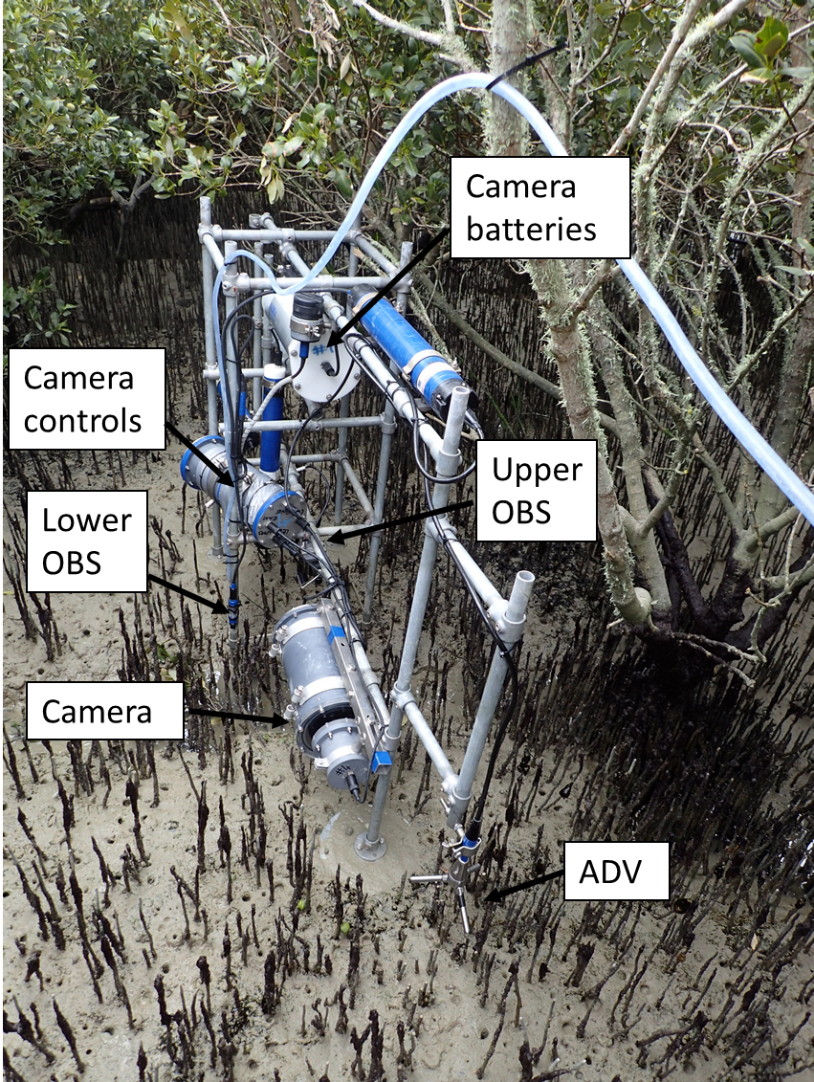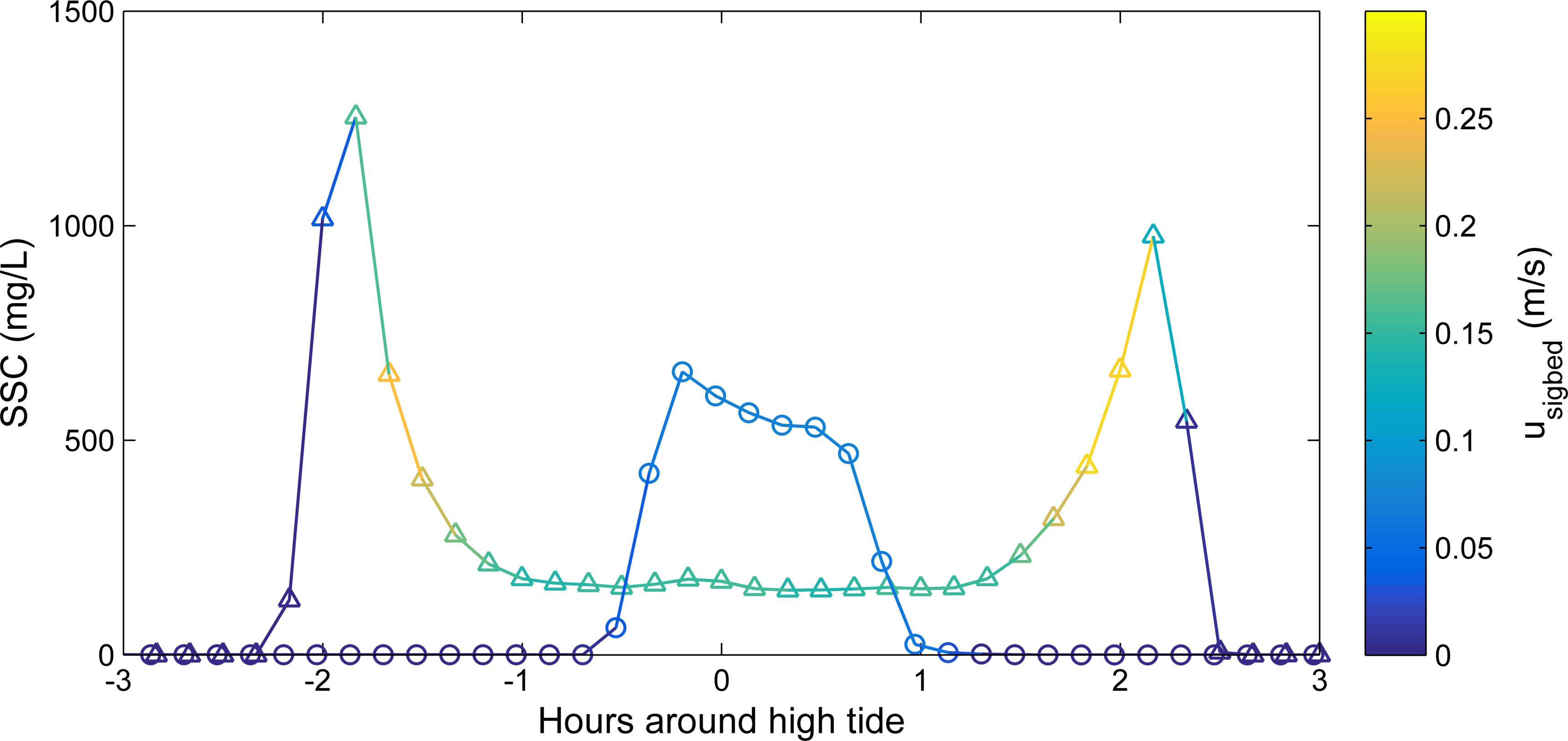Reports: ND856786-ND8: Controls on Carbon Burial Rates in Subtropical Environments: The Role of Spatial Heterogeneity of Vegetation Density and Sediment Supply
Julia C. Mullarney, PhD, University of Waikato
Karin R. Bryan, PhD, University of Waikato
Over the past year, work has focussed in two areas. The first major field experiment has been successfully completed and data analysis undertaken. In this experiment we deployed an array of instruments focussed around the centre (in E/W) of the mangrove forest in the Firth of Thames, New Zealand. Measurements were collected around the transition zone from the intertidal mudflat, across the fringe region into the forest. There were 5 measurement sites: with the outermost site (x=-50 m) located on the intertidal mudflat, one at the fringe (x=50 m) and three extending into the forest (150 m). At each location, a variety of hydrodynamic data was obtained including flow speeds, water depths, and suspended sediment concentrations at two heights above the bed. Additionally, floc cameras were used to obtain images of flocculated particles within the water column (Figure 1).
Figure 1. Frame deployed within the Firth of Thames mangrove forest (~70 m into the forest). ADV is Acoustic Doppler Velocimeter. OBS is optical backscatter sensor. A downwards-looking Acoustic Doppler Current Profiler (ADCP) also extends out from the far side of the frame in this image.
Data underwent quality control prior to calculating the sediment fluxes into and out of the forest. Several notable findings from the data arose. These include:
On the mudflat, there was substantial variability in the direction of the long-shore currents, which exhibited a strong dependence on the wind direction. Near-bed SSCs were large, and on occasion, concentrations around 6g/L were measured. As expected, in general, more energetic wave activity corresponded to larger SSCs; however, there were periods with large SSCs but little wave activity suggesting that, for these times at least, sediment is being advected into the region rather than being locally resuspended. On the mudflat, SSC exhibited the classic u-shape over the tidal cycle, indicating that the larger shear stresses during shallow water depths or from larger waves can either resuspend sediment or prevent sediment settling. However, further into the forest, the pattern changed with maximum SSCs typically occurring close to high tide (Figure 2).
Figure 2. Example of SSC over a tidal cycle characterised by small waves on the mudflat (significant wave heights of 0.15 m). Triangles indicate measurements from the intertidal mudflat (21 cm above the bed), circles indicate measurements from 150 m inside the forest (23 cm above the bed). Colours correspond to the wave orbital velocities at the bed. Points where SSC=0 correspond to times when the instruments were out of the water.
One striking observation was that, for days with larger wave energy, sediment flux on the mudflat was directed offshore for the entire duration of the tide. Although velocities in the upper part of the water column were not measured, OBS measurements show that SSC decreases with increasing elevation from the bed, and hence are not expected to significantly alter the estimated flux patterns. Over the duration of the experiment, cumulative sediment fluxes on the mudflat (site 1) were large (850 kg/m2) and offshore, whereas net fluxes at all other sites were smaller and onshore (Figure 3). If the sediment is being removed locally, this distribution of fluxes would imply scouring between offshore of the fringe and (between sites 1 and 2) and inside the forest (between sites 3 and 4) and deposition in other regions. There was some evidence for scour on the intertidal flat around site 1 in the form of runnels and scour around pneumatophores at site 2 in the fringe region. Further into the forest at sites 3, 4 and 5, despite denser pneumatophores, scour is not present. Alternatively, or in addition to, local erosion, sediment may be being advected into and out of different regions in the forest by longshore currents.
Figure 3. Cumulative sediment fluxes over the duration of the experiment. Site 1 is on the intertidal mudflat, site 2 is located on the fringe (boundary between mudflat and forest) and sites 3 to 5 are located at increasing distances within the forest.
Obtaining usable floc camera images proved challenging owing to difficulties in finding a single set of camera settings suitable for images over the full range of conditions (both temporally and spatially). Therefore, photos were often overexposed or too dark. However, usable images were obtained from sites 1 and 3 over two tides, allowing for preliminary qualitative analysis of flocs to be conducted. Large, medium and small sized floc were observed at both sites (Figure 4) and preliminary indications are that, inside the forest, there were fewer large flocs. During ebb tide the number of large flocs at both sites appeared to increase. On the mudflat, overall numbers of flocs declined at high tide, whereas in the forest floc numbers remained elevated throughout most of the tide. Future work will focus on quantitative analysis of floc size and obtaining particle size distributions.
Figure 4. Example floc camera image from site 1 on the mudflat showing presence of a range of floc sizes.
The second area of focus has been the development of an idealised numerical model of the Waihou River which discharges into the SW sector of the Firth of Thames. This model will be used to explore the interactions of a sediment plume and the mangrove forest, and the subsequent consequences for sediment transport and deposition. The model will also be used to inform the instrument deployment sites for the second major field experiment (planned for 2018).
This grant has supported one MSc student who will submit her thesis in September 2017 and has allowed me to strengthen collaborations with NIWA. The student will present her results at the New Zealand Coastal Society Conference in November 2017. Secondly, the grant has supported a PhD student, who commenced his PhD in April, and is currently working towards obtaining his confirmed enrolment. His project will focus on the sediment transport and deposition arising from the interaction between the river plumes, hydrodynamics and vegetation within the Firth of Thames mangrove forest.















